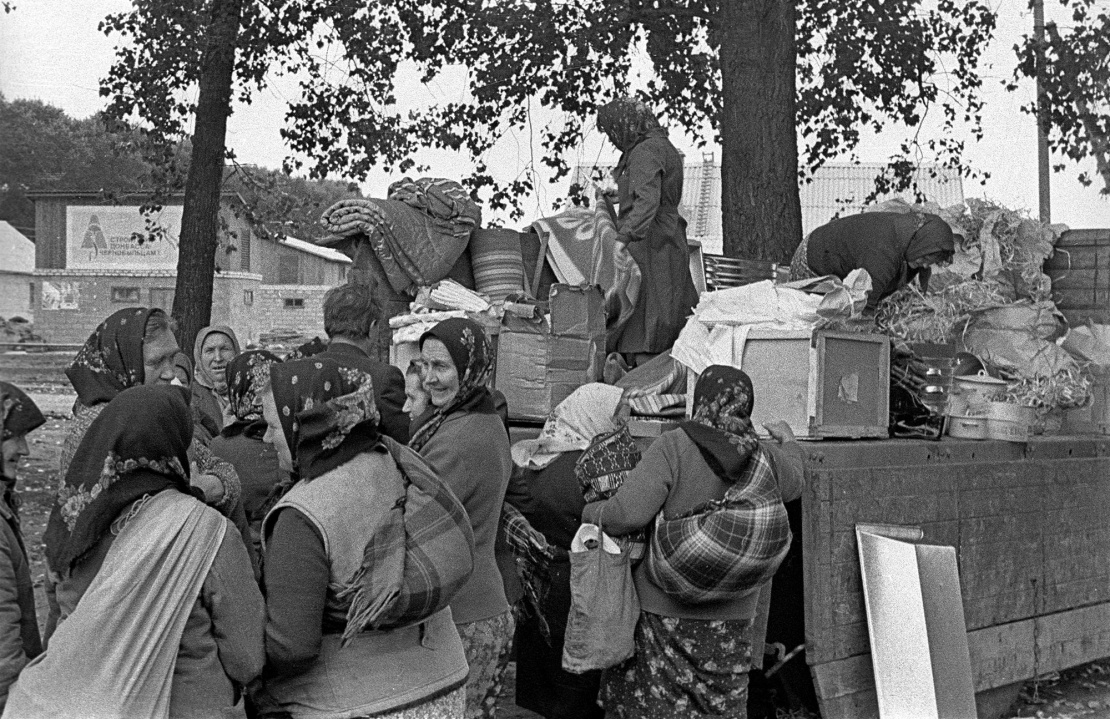Evacuation
The first report about the accident at the Chornobyl NPP appeared only 36 hours later, when the USSR State Commission decided to evacuate the residents of Pripyat, the city closest to the nuclear power plant with a population of about 50,000. At noon on April 27, 1986, the Pripyat street radio announced the "temporary evacuation" of the cityʼs residents.
To reduce baggage and prevent panic, people were told they could return home in three days. They were advised to take with them only "documents, absolutely necessary things, and also, in the first instance, food." Other things, such as dishes and childrenʼs toys, as well as domestic animals, were not allowed to be taken out.
At the state level, the first short message appeared only on April 28 at 9:00 p.m.: "There was an accident at the Chornobyl nuclear power plant. One of the nuclear reactors was damaged. Measures are being taken to eliminate the consequences of the accident. Assistance is provided to the injured. A government commission has been created."
As of May 6, more than 115,000 people were evacuated from the 30-kilometer zone around the Chornobyl nuclear power plant. This area suffered from radiation the most. Later it was called the Chornobyl Exclusion Zone. It included the north of the Polisky and Ivankivsky districts of the Kyiv region, where the power plant is located, the cities of Chornobyl and Pripyat, as well as part of the Zhytomyr region up to the border with Belarus. Hundreds of small villages that were at the epicenter of pollution were razed to the ground by bulldozers.
Most people were evicted to neighboring districts of Kyiv region: Zgurivskyi, Makarivskyi, Vasylkivskyi, Yagotynskyi and others. And at the end of 1986, the youngest city in Ukraine — Slavutych — was started to be built for ChNPP workers and their families. Construction was completed in record time — the first residents moved into their apartments in 1987-1988.
"Car shop" with essential goods for refugees from the Chornobyl exclusion zone. 1986.
Volunteers who built houses for refugees from the Chornobyl Exclusion Zone. 1986.
At the end of August and the beginning of September 1986, separate residential areas were built in several villages of the Kyiv region for people evacuated from the Chornobyl Exclusion Zone. For example, in Trubivshchyna of Yagotyn district and Arkadiyivka of Zguriv district. A new village of the same name was built in the Vasylkiv district of the Kyiv region for the displaced people from Lubyanka, Polisky district, which was in a 30-kilometer zone.
For the first time, IDPs were allowed to visit houses and visit graves in cemeteries in the exclusion zone only during the memorial week after Easter 1989.
The new Lubyanka village for Chornobyl refugees was built ahead of schedule by August 23, 1986. “Our gift to the people affected by Chornobyl disaster — the village of Lubyanka got built ahead of schedule to the anniversary of Kharkivʼs liberation from the Nazi occupiers!” is written on the transparant.
Residents of the 30-kilometer zone were allowed to visit cemeteries for the first time after the disaster. The village of Paryshiv, May 1989.
Restarting the plant after the accident
After the accident, the work of the Chornobyl power plant was suspended, and more than 240,000 people were thrown into liquidation of the consequences of the disaster. They dismantled the debris, carried out decontamination of the territory and erected a concrete sarcophagus around the fourth power unit destroyed by the explosion.
At the end of May 1986, the USSR government decided to restore the operation of three power units of the station, and not to complete the building of the fifth and sixth units. The first power unit was launched on October 1, 1986, the second on November 5, and the third on December 4, 1987.
The central entrance of the Chornobyl NPP. 1989.
A concrete sarcophagus above the destroyed fourth power unit of the Chornobyl NPP. 1989.
In times of independent Ukraine
After the fire at the second power unit of the Chornobyl Nuclear Power Plant in October 1991, the Verkhovna Rada (the parliament) of already independent Ukraine passed a resolution to stop the operation of the plant until 1993. But in October 1993, at the proposal of the Cabinet of Ministers, the Council canceled the previous resolution and decided "to continue the operation of the Chornobyl NPP for the period determined by its technical condition."
Employees of the Chornobyl Nuclear Power Plant undergo procedures before being sent to the station by train from Slavutych. 1996. “Dirty wardrobe” is written above the door.
Engineer behind the control panel of the third power unit of the Chornobyl NPP. 1996.
Under the influence of Western countries, in December 1995, Ukraine signed a Memorandum of Understanding with the members of the G7 and the European Commission, in which it undertook to close the Chornobyl NPP by 2000.
The first power unit stopped working in November 1996, the second was stopped after a fire in 1991. And the last, third power unit was stopped on December 15, 2000 at 1:17 p.m. by the order of the then President of Ukraine, Leonid Kuchma, during the telebridge "Chornobyl NPP — National Palace "Ukraine".
Translated from Ukrainian by Anton Semyzhenko.
